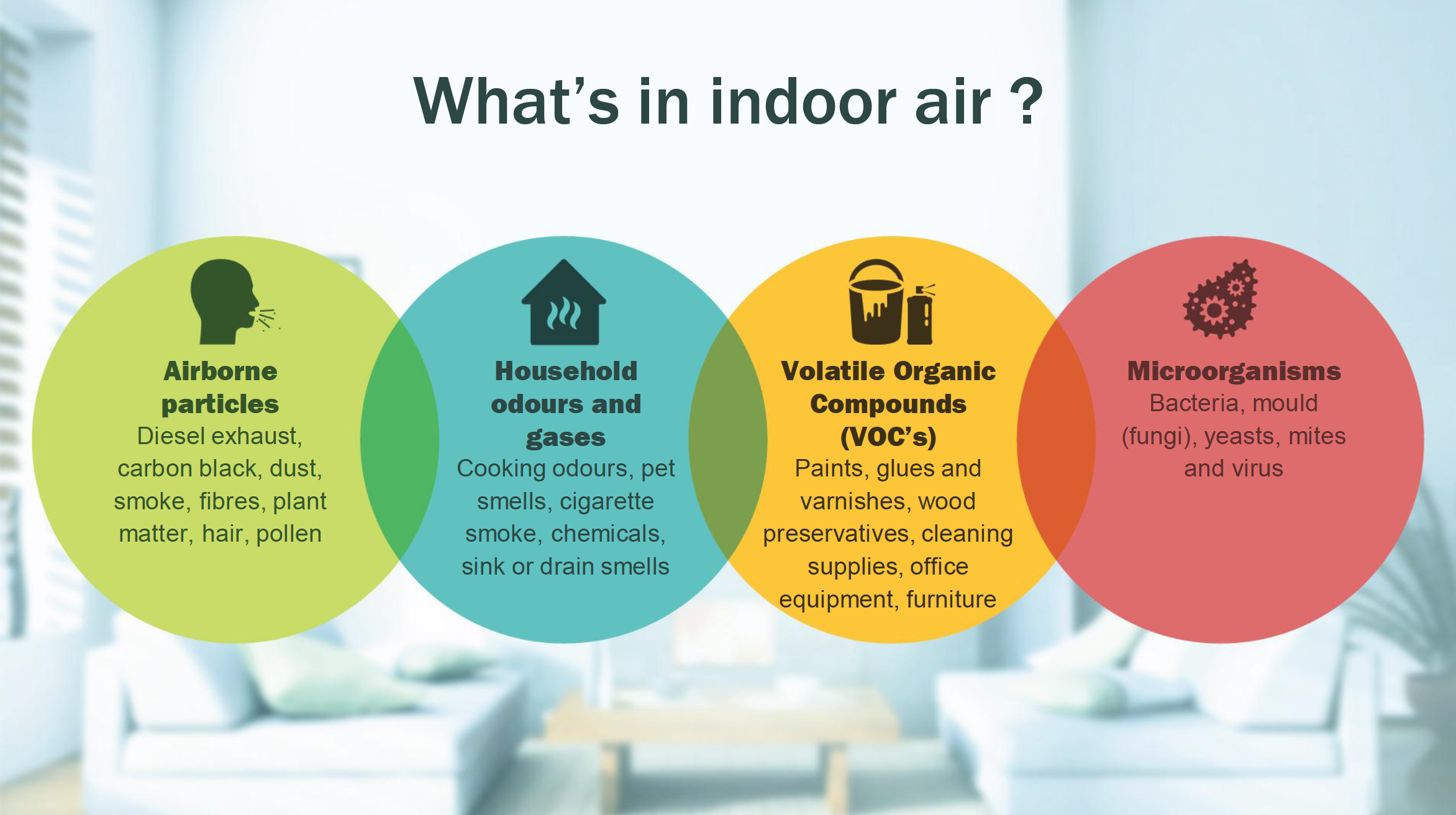Indoor air quality significantly impacts our overall well-being and can influence everything from our physical health to our cognitive function. With many of us spending over 90% of our time indoors, it is crucial to understand the role that indoor air health plays in our daily lives. Factors such as indoor pollution, ventilation rates, and the materials used in our buildings can either promote a healthy environment or contribute to various ailments. In workplaces and schools, where air quality is often overlooked, the condition of the air we breathe can even affect productivity levels and mental focus. As we strive for healthier buildings, ensuring clean and well-ventilated indoor spaces is essential for optimizing our health and enhancing our quality of life.
The healthiness of the air we breathe indoors is becoming an increasingly important topic as we spend a significant portion of our lives in enclosed environments. Terms like workplace air quality and environmental ergonomics highlight the need for better building designs that prioritize the inhabitants’ welfare. By addressing the concerns of indoor pollution and implementing effective air filtration systems, we can create spaces that not only protect our physical health but also bolster our mental capabilities. These considerations are vital for developing healthy buildings that promote cognitive function and overall productivity. Ultimately, understanding the nuances of indoor air quality allows us to make informed decisions for ourselves and future generations.
Understanding Indoor Air Quality and Its Impact on Health
Indoor air quality (IAQ) is crucial to our overall health, especially considering that the average American spends approximately 90% of their time indoors. Poor indoor air quality can lead to a range of health issues, from respiratory problems to exacerbated allergies, making awareness of this aspect essential. Factors like inadequate ventilation, indoor pollution, and the presence of harmful chemicals can deteriorate the air we breathe, affecting not only physical health but also cognitive function and overall well-being.
Research indicated by experts such as Joseph Allen and John Macomber emphasizes that healthy buildings significantly contribute to our health and productivity. A well-ventilated space can enhance cognitive function and reduce symptoms associated with indoor air pollution. Consequently, improving air quality in workplaces and homes should be a priority for building designers and managers, creating an environment that not only promotes health but also inspires higher levels of mental engagement.
Key Factors Influencing Workplace Air Quality
Workplace air quality is influenced by several factors, including building ventilation, outdoor air pollution infiltration, and the materials used within the building. An increase in air circulation and filtration systems can dramatically improve workers’ comfort and performance, as documented in various studies. For instance, alterations in building design, such as introducing more natural light or utilizing non-toxic materials, can also help to improve indoor air health.
Moreover, awareness among employees regarding the impact of their environment on health promotes a culture of wellness. When organizations prioritize indoor air quality, they not only comply with health guidelines but also reap benefits such as increased productivity and decreased sick days among workers. It’s important for building management teams to recognize that healthier workplaces are not just a trend but a necessity for achieving optimal employee performance.
The Role of Healthy Buildings in Promoting Well-Being
Healthy buildings are designed with a focus on enhancing the health and well-being of their occupants. This approach includes the integration of effective ventilation systems, which significantly contribute to improved indoor air quality. By ensuring appropriate air filtration and reducing exposure to harmful pollutants, these buildings create safer environments for residents and workers alike, thereby promoting better physical and mental health.
Moreover, design elements that foster interaction with nature, such as green spaces or the use of natural materials, can enhance the overall aesthetic and emotional atmosphere of a building. This not only boosts morale but also leads to enhanced cognitive function and productivity among occupants. Investing in healthy building practices is essential for adapting to modern health challenges and ensuring that indoor environments contribute positively to occupant health.
Strategies to Improve Indoor Air Quality in Homes
Improving indoor air quality in homes is vital for maintaining a healthy living environment. Simple strategies include regular ventilation, air purification systems, and maintaining humidity levels to prevent mold growth. Homeowners are encouraged to open windows regularly to allow fresh air to circulate and reduce indoor pollutants. Additionally, using HEPA filters and air purifiers can significantly capture harmful particles from the air, improving overall air health.
Furthermore, being mindful of household products that emit VOCs (volatile organic compounds) is essential for reducing indoor pollution. Choosing low-emission paints, adhesives, and cleaning products can drastically improve the air quality within the home. Educating family members on the importance of indoor air health and providing a clean living space contributes not only to a healthier environment but also to improved well-being for all occupants.
The Connection Between Indoor Air Quality and Cognitive Function
Research shows a significant link between indoor air quality and cognitive function, particularly in settings like offices and schools. Poor air quality can lead to issues such as fatigue, reduced concentration, and cognitive decline. Studies have found that enhanced ventilation systems can improve the cognitive performance of employees, directly impacting productivity levels and decision-making abilities.
Furthermore, as the demand for healthier work and learning environments rises, addressing air quality becomes a critical component in fostering cognitive health. Building owners and managers should strive to implement solutions that monitor and enhance air quality, ensuring that occupants can thrive in environments that support their mental sharpness and overall well-being.
Addressing Indoor Pollution for Better Health Outcomes
Indoor pollution is a pressing concern that often gets overshadowed by outdoor air quality issues. However, it is essential to recognize that pollutants such as dust, mold, and chemical emissions can severely impact health. Understanding the sources of indoor pollution, including furniture off-gassing and poor ventilation, can lead to more effective control strategies and healthier environments.
Taking actionable steps to mitigate indoor pollution greatly enhances the overall air quality. Regular cleaning, utilizing non-toxic materials, and investing in air purifiers can significantly reduce exposure to harmful substances. By prioritizing indoor pollution control, we can create spaces that are not only safer but also conducive to healthier living and working conditions.
The Importance of Ventilation in Maintaining Indoor Air Quality
Ventilation plays a critical role in maintaining optimal indoor air quality by allowing the exchange of stale indoor air with fresh outdoor air. Proper ventilation systems, whether natural or mechanical, help remove pollutants and moisture, essential in preventing the build-up of harmful substances indoors. For instance, buildings equipped with advanced HVAC systems can significantly enhance airflow and filtration, leading to healthier indoor environments.
Moreover, adequate ventilation has been shown to improve comfort levels, reduce respiratory problems, and foster a higher quality of life for occupants. Organizations and homeowners need to prioritize effective ventilation solutions and integrate them into building designs, ensuring that indoor health is safeguarded and occupants can thrive in a clean and safe atmosphere.
Educating on Indoor Air Health for a Healthier Future
Education plays a foundational role in enhancing awareness about indoor air health and its implications on well-being. By providing information about indoor air quality issues, potential health risks, and preventive measures, occupants can make informed decisions to improve their surroundings. Schools, workplaces, and homes should encompass educational programs that promote understanding of indoor pollution sources and health benefits of clean air.
Furthermore, fostering a community culture centered around healthy living can lead to collective improvements in indoor air quality. Empowering individuals and organizations to take proactive steps towards addressing indoor air health not only enhances personal well-being but contributes to a broader societal shift towards healthier living conditions.
Analyzing the Economic Impact of Poor Indoor Air Quality
The economic repercussions of poor indoor air quality are substantial, impacting both businesses and healthcare systems. For organizations, decreased employee productivity and increased health care costs due to indoor pollution-related illnesses pose significant financial burdens. Studies indicate that improving workplace air quality can lead to substantial cost savings through reduced absenteeism and higher employee efficiency.
Additionally, the broader public health costs associated with poor indoor air are often overlooked. Increased occurrences of respiratory conditions and other health issues translate into higher healthcare expenditures for society. Addressing indoor air quality is not just a health imperative but an economic strategy; by investing in healthier environments, we invest in productivity, health, and overall community well-being.
Frequently Asked Questions
How does indoor air quality affect workplace air quality?
Indoor air quality significantly impacts workplace air quality as it determines the levels of pollutants and allergens present in the office environment. Poor ventilation, high levels of indoor pollution, and inadequate air filtration can lead to increased illness, decreased productivity, and lower cognitive function among employees.
What are common indoor pollutants that can affect indoor air health?
Common indoor pollutants affecting indoor air health include volatile organic compounds (VOCs), mold, dust mites, pet dander, and carbon dioxide. These pollutants can originate from building materials, furniture, cleaning products, and even outdoor air, impacting our well-being.
How can improving indoor air quality enhance cognitive function?
Improving indoor air quality can enhance cognitive function by increasing ventilation rates and reducing indoor pollution levels. Studies have shown that better air quality in buildings, through proper ventilation and filtration, can boost focus and decision-making abilities among occupants.
What role do healthy buildings play in improving indoor air quality?
Healthy buildings prioritize indoor air quality by integrating design features that enhance ventilation, reduce pollutants, and maintain humidity levels. These practices contribute to better health outcomes and increased productivity for those who inhabit these spaces.
How can I assess the indoor air quality of my home?
To assess indoor air quality, you can use air quality monitors that measure levels of VOCs, carbon dioxide, humidity, and particulate matter. Additionally, observing signs of indoor pollution, such as mold growth, musty odors, or frequent respiratory issues, can provide insight into potential air quality problems.
What are effective strategies for reducing indoor pollution in homes?
Effective strategies for reducing indoor pollution include increasing natural ventilation by opening windows, using high-efficiency particulate air (HEPA) filters in HVAC systems, regularly changing air filters, and limiting the use of products that emit VOCs. Implementing these strategies can significantly improve indoor air quality.
Can plants improve indoor air quality and overall health?
Yes, certain indoor plants can improve air quality by absorbing toxins and releasing oxygen. However, while plants contribute positively, they should not be solely relied upon for maintaining healthy indoor air; proper ventilation and pollution source control are also crucial.
What impact does indoor air quality have on children’s health?
Indoor air quality can greatly affect children’s health as they are more susceptible to the effects of indoor pollution. Poor air quality has been linked to respiratory issues, allergies, and cognitive development problems in children. Ensuring healthy indoor environments is crucial for their well-being.
How does increased ventilation contribute to better indoor air quality?
Increased ventilation contributes to better indoor air quality by diluting indoor pollutants, bringing in fresh outdoor air, and reducing the concentration of harmful substances in the air. This practice is essential for creating healthier indoor environments, especially in workplaces and schools.
What can businesses do to ensure healthy indoor air quality?
Businesses can ensure healthy indoor air quality by conducting regular air quality assessments, improving ventilation systems, using air purifiers, and educating employees about the importance of maintaining clean indoor spaces. Implementing these measures can enhance workplace health and productivity.
| Question | Options | Key Points |
|---|---|---|
| 1. How much of their lives do Americans on average spend indoors? | – 80% – 65% – 90% – 75% |
Americans generally spend 80% of their lives indoors, indicating significant exposure to indoor air quality. |
Summary
Indoor air quality is crucial to our health and well-being, significantly affecting our focus and productivity. Understanding the impact of our indoor environments, such as homes and workplaces, allows us to take actionable steps to improve air quality. These actions can include ensuring proper ventilation, utilizing air filtration systems, and being aware of the pollutants that may come from neighboring units. By prioritizing indoor air quality, we can create healthier spaces that foster better health outcomes.





